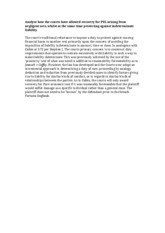 A tort is a kind of civil liability exactly where the liability for a single individual for a wrong accomplished to a different is raised as an problem in between them. A contract could expressly specify a responsibility which can give rise to a separate and actionable breach of contract. The initially and foremost question ought to be no matter whether there is a precise contractual duty made by an express term of the contract which is co-in depth with the widespread law duty of care which the representee alleges the representor has breached. Thus, whether or not the entire agreement clause excludes Intrawest from liability for negligent misrepresentation is not easily answered. By contrast, tortious claims permit all losses to be recovered which are reasonably foreseeable at the time the tort occurred.
A tort is a kind of civil liability exactly where the liability for a single individual for a wrong accomplished to a different is raised as an problem in between them. A contract could expressly specify a responsibility which can give rise to a separate and actionable breach of contract. The initially and foremost question ought to be no matter whether there is a precise contractual duty made by an express term of the contract which is co-in depth with the widespread law duty of care which the representee alleges the representor has breached. Thus, whether or not the entire agreement clause excludes Intrawest from liability for negligent misrepresentation is not easily answered. By contrast, tortious claims permit all losses to be recovered which are reasonably foreseeable at the time the tort occurred.
On the basis of that evidence, and in light of the absence in the trial judge’s factors of a clear conclusion as to what Checo would have accomplished had the misrepresentation not been produced, the Court of Appeal was in our view justified in producing its own locating that Checo would have entered the contract in any occasion, albeit at a higher bid.
A pre-contractual misrepresentation will lead to concurrent liability exactly where a given incorrect prima facie supports an action in each contract and tort, and the contract does not indicate that the parties intended to limit or negate the tort duty. The court’s choice renders broader tortious rules inapplicable in such situations and adds to prior developments restricting the usefulness in a building context of parties bringing concurrent claims in tort as well as contract.
Even though the Court of Appeal disagreed that the loss claimed by Wellesley was too remote for a claim in contract, it concluded that the tortious rule need to mirror the contractual position in instances of concurrent liability. To start, I will outline the basis of every claim in contract and in tort just before contemplating the nuances between actions and concluding how such nuances impact a claimant. The first region of distinction is the application of limitation periods, even though a textual evaluation of the Limitation Act shows small distinction in the rules, the sensible application of limitation in tort and contract is distinct.
In BG Checo, the Supreme Court of Canada explained the standard rule governing concurrent liability, by saying that where a given wrong prima facie supports an action in contract and in tort, the party may possibly sue in either or each, except where the contract indicates that the parties intended to limit or negative the appropriate to sue in tort” (BG Checo, para 15).









